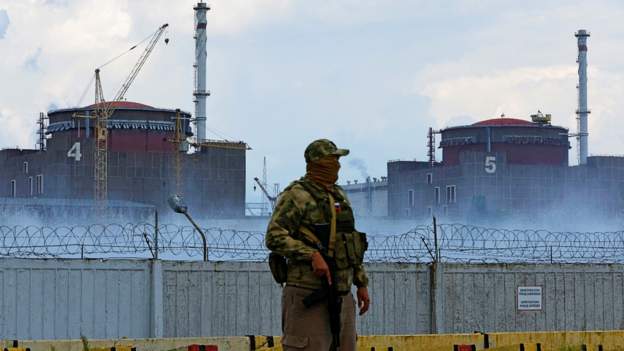On Saturday, the International Atomic Energy Agency (IAEA) reported the Zaporizhzhia nuclear power plant, the largest nuclear power plant in Europe, lost power to its last remaining external power line after a fire occurred at the plant forcing the shutdown.
Since the beginning of the war, the safety of the nuclear power plant sitting in the midst of a war zone has become a point of concern as bombs from both sides come close to damaging or even destroying the plant.
Fortunately, officials reported that a reserve line continues to supply the grid with electricity after the final external power line was shut off.
Although the plant is still up and running for now, only two of the station’s six reactors remain operational, the IAEA stated.
Blame on both sides: Who is bombing the Zaporizhzhia plant?
The plant was shortly seized after the war began on February 24, with Russian troops surrounding the area of Enerhodar, the city in the Eastern Ukraine’s Zaporizhzhia oblast, which is home to the nuclear power plant.
Since then, both sides have cast blame on the other over intense bombing in the area that has led to destruction and shutdowns near and at the site of the plant.
Ukraine and the West have since asserted that Russia is holding the plant hostage, storing dangerous weapons at the site in order to keep Ukraine from firing on it, while Russia has denied any such allegations, and has resisted calls to relocate troops and demilitarize the surrounding area.
Likewise, Russia often exerts questions over why they would bomb their own forces at the plant, accusing Ukrainian forces on Tuesday of forming a counteroffensive to recapture the plant.
Russia has also accused Ukraine of dropping three bombs near the plant’s nuclear storage unit, the solid radioactive waste storage unit, and one of the power units.
Neither side’s claims were able to be verified.
UN sends the IAEA on a mission to inspect the plant
A week ago, as we reported here, spurred by the threat of nuclear catastrophe, UN watchdog IAEA, headed by IAEA Director-General Rafael Grossi, was sent into Ukraine to inspect the plant and ensure the safety of the workers and nearby community.
Ukraine’s foreign ministry spokesperson said the team was supposed to arrive last Monday to make necessary inspections.
On Monday, Ukrainian President Volodymyr Zelenskyy warned of a looming “radiation catastrophe” and stated Russia’s shelling of the plant showed a lack of care for the IAEA mission.
However, in Moscow, Kremlin spokesperson Dmitry Peskov stated Russia would ensure the IAEA mission proceeded and insisted Ukraine stop bombing the nuclear power plant in order to ensure the safety of the entire continent.
I am finishing my first visit to #Ukraine’s #Zaporizhzhya Nuclear Power Plant.@IAEAorg is here to stay and will maintain a continued presence at #ZNPP. pic.twitter.com/k4zO3IMe2I
— Rafael MarianoGrossi (@rafaelmgrossi) September 1, 2022
According to IAEA officials, the line was shut down on Saturday after a fire broke out at the plant, forcing the staff to cut off the external power line in order to properly extinguish the flame. Despite the scare, they noted the plant is still operating safely, and that the external power line was still intact and would be online shortly.
IAEA gives UN Security Council urgent message
After inspecting the plant last week, Grossi published the IAEA’s findings on Tuesday.
In their assessment, the IAEA reported there is an “urgent need” to take measures to prevent a nuclear disaster at the plant.
Measures recommended by the IAEA include a nuclear safety and security protection zone to be established after physical damage caused by shelling was seen at the plant.
Read: A no-fire zone around the plant, a demilitarized zone.
The team noted on arrival that the road surface, walls and windows of various buildings at the plant were damaged as well as an overpass connecting the reactor units.
The report warned the situation posed a “constant threat to nuclear safety and security” due to the potential large-scale destruction of critical safety features.
In addition to physical damage, the assessment notes damage to staff morale at the plant due to constant pressure and high stress — where Ukrainian staffers work around the clock because of limited staff — could heighten the potential of human error.
The IAEA called for work environment improvements to ensure the plant is adequately monitored.
As of now, two remaining IAEA staff remain on sight to continue monitoring the plant’s status — a mission that could remain of utmost importance until the plant is in safe hands.
Editor’s Note: The opinions expressed here by Impakter.com columnists are their own, not those of Impakter.com –In the Featured Photo: Zaporizhzhia nuclear power plant in Ukraine on August 8, 2022. Source: REUTERS/Alexander Ermochenko, Flickr.








